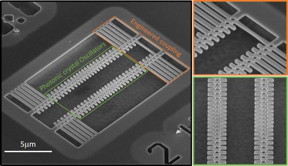

| Date | 4th, Jul 2019 |
|---|
Home > Press > New study shows nanoscale pendulum coupling
 Researchers could synchronize two crystal optomechanical oscillators mechanically coupled.
CREDIT
D. Navarro
Researchers could synchronize two crystal optomechanical oscillators mechanically coupled.
CREDIT
D. Navarro
Abstract: In 1665, Lord Christiaan Huygens found that two pendulum clocks, hung in the same wooden structure, oscillated spontaneously and perfectly in line but in opposite directions: the clocks oscillated in anti-phase. Since then, synchronization of coupled oscillators in nature has been described at several scales: from heart cells to bacteria, neural networks and even in binary star systems -spontaneously synchronized.
Barcelona, Spain | Posted on July 3rd, 2019
Mechanical oscillators are typical in these systems. In the nanoscale, the challenge is to synchronize these. In these lines, an article published in the journal Physical Review Letters -by a team of researchers from the Institute of Nanoscience and Nanotechnology of the UB (IN2UB) together with ICN2 researchers showed a version of mechanic oscillators at a nanoscale. Through a series of experiments, researchers could synchronize two crystal optomechanical oscillators mechanically coupled, located in the same silicon platform and activated through independent optical impulses. These nanometric oscillators have a size of 15 micrometres per 500 nanometres.
While a mechanical pendulum receives impulses from the clock to keep its movement, the optomechanical pendulums use the pressure from radiation, but interaction of oscillators is the same in both experiments. The study also shows that the collective dynamics can be controlled acting externally on one oscillator only.
"Results show a good base for the creation of reconfigurable networks of optomechanical oscillators thanks to these collective dynamics that are dominated by a weak mechanical coupling. This could have applications in photonics, for instance, for pattern recognition tasks or a more complex cognitive process", notes Daniel Navarro Urrios, from IN2UB, who led the research.
####
For more information, please click here
Contacts:Bibiana Bonmat�
0034-934-035-544
Copyright © University of Barcelona
If you have a comment, please Contact us.
Issuers of news releases, not 7th Wave, Inc. or Nanotechnology Now, are solely responsible for the accuracy of the content.
News and information
![]() Two opposing approaches could give lithium-sulfur batteries a leg up over lithium-ion July 1st, 2022
Two opposing approaches could give lithium-sulfur batteries a leg up over lithium-ion July 1st, 2022
![]() Efficiently processing high-quality periodic nanostructures with ultrafast laser July 1st, 2022
Efficiently processing high-quality periodic nanostructures with ultrafast laser July 1st, 2022
![]() Photonic synapses with low power consumption and high sensitivity are expected to integrate sensing-memory-preprocessing capabilities July 1st, 2022
Photonic synapses with low power consumption and high sensitivity are expected to integrate sensing-memory-preprocessing capabilities July 1st, 2022
Physics
![]() Flexing the power of a conductive polymer: A new material holds promise for the next generation of organic electronics June 24th, 2022
Flexing the power of a conductive polymer: A new material holds promise for the next generation of organic electronics June 24th, 2022
![]() Observation of fractional exclusion statistics in quantum critical matter May 27th, 2022
Observation of fractional exclusion statistics in quantum critical matter May 27th, 2022
Possible Futures
![]() Sieving carbons: Ideal anodes for high-energy sodium-ion batteries July 1st, 2022
Sieving carbons: Ideal anodes for high-energy sodium-ion batteries July 1st, 2022
![]() An artificial intelligence probe help see tumor malignancy July 1st, 2022
An artificial intelligence probe help see tumor malignancy July 1st, 2022
![]() Photon-controlled diode: an optoelectronic device with a new signal processing behavior July 1st, 2022
Photon-controlled diode: an optoelectronic device with a new signal processing behavior July 1st, 2022
Discoveries
![]() Sieving carbons: Ideal anodes for high-energy sodium-ion batteries July 1st, 2022
Sieving carbons: Ideal anodes for high-energy sodium-ion batteries July 1st, 2022
![]() Efficiently processing high-quality periodic nanostructures with ultrafast laser July 1st, 2022
Efficiently processing high-quality periodic nanostructures with ultrafast laser July 1st, 2022
![]() Photonic synapses with low power consumption and high sensitivity are expected to integrate sensing-memory-preprocessing capabilities July 1st, 2022
Photonic synapses with low power consumption and high sensitivity are expected to integrate sensing-memory-preprocessing capabilities July 1st, 2022
Announcements
![]() Two opposing approaches could give lithium-sulfur batteries a leg up over lithium-ion July 1st, 2022
Two opposing approaches could give lithium-sulfur batteries a leg up over lithium-ion July 1st, 2022
![]() Efficiently processing high-quality periodic nanostructures with ultrafast laser July 1st, 2022
Efficiently processing high-quality periodic nanostructures with ultrafast laser July 1st, 2022
![]() Photonic synapses with low power consumption and high sensitivity are expected to integrate sensing-memory-preprocessing capabilities July 1st, 2022
Photonic synapses with low power consumption and high sensitivity are expected to integrate sensing-memory-preprocessing capabilities July 1st, 2022
Interviews/Book Reviews/Essays/Reports/Podcasts/Journals/White papers/Posters
![]() Sieving carbons: Ideal anodes for high-energy sodium-ion batteries July 1st, 2022
Sieving carbons: Ideal anodes for high-energy sodium-ion batteries July 1st, 2022
![]() An artificial intelligence probe help see tumor malignancy July 1st, 2022
An artificial intelligence probe help see tumor malignancy July 1st, 2022
![]() Photon-controlled diode: an optoelectronic device with a new signal processing behavior July 1st, 2022
Photon-controlled diode: an optoelectronic device with a new signal processing behavior July 1st, 2022
Research partnerships
![]() New technology helps reveal inner workings of human genome June 24th, 2022
New technology helps reveal inner workings of human genome June 24th, 2022
![]() Boron nitride nanotube fibers get real: Rice lab creates first heat-tolerant, stable fibers from wet-spinning process June 24th, 2022
Boron nitride nanotube fibers get real: Rice lab creates first heat-tolerant, stable fibers from wet-spinning process June 24th, 2022
